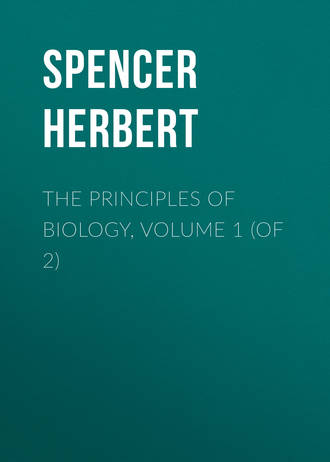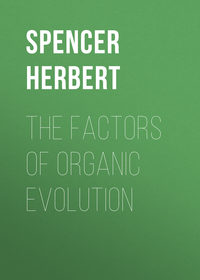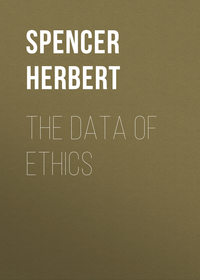 полная версия
полная версияThe Principles of Biology, Volume 1 (of 2)
Now in this fissiparous mode of multiplication, which "is amazingly productive, and indeed surpasses in fertility any other with which we are acquainted,"72 we see most clearly the antagonism between individuation and reproduction. We see that the reproductive process involves destruction of the individual; for in becoming two, the parent fungus or polygastrian must be held to lose its own proper existence; and when it breaks up into a numerous progeny, does so still more completely. Moreover, this rapid mode of multiplication not only destroys the individuals in whom it takes place, but also involves that their individualities, whilst they continue, shall be of the lowest kind. For assume a protozoon to be growing by imbibition at a given rate, and it follows that the oftener it divides the smaller must be the size it attains to; that is, the smaller the development of its individuality. And a further manifestation of the same truth is seen in the fact that the more frequent the spontaneous fission the shorter the existence of each individual. So that alike by preventing anything beyond a microscopic bulk being attained, by preventing the continuance of this in its integrity beyond a few hours, and by being fatal when it occurs, this most active mode of reproduction shows the strongest antagonism to individual life.
§ 6. Whether or not we regard reproduction as resulting from a repulsive force (and, as seen above, both Owen and Carpenter lean to some such view), and whether or not we consider the formation of the individual as due to the reverse of this – an attractive force – we cannot, on studying the phenomena, help admitting that two opposite activities thus generalized are at work; we cannot help admitting that the aggregative and separative tendencies do in each case determine the respective developments of the individual and the race. On ascending one degree in the scale of organic life, we shall find this truth clearly exemplified.
For if these single-celled organisms which multiply so rapidly be supposed to lose some of their separative tendency, what must be the result? They now not only divide frequently, but the divided portions fly apart. How, then, will a diminution of this separative tendency first show itself? May we not expect that it will show itself in the divided portions not flying apart, but remaining near each other, and forming a group? This we find in nature to be the first step in advance. The lowest compound organisms are "simple aggregations of vesicles without any definite arrangement, sometimes united, but capable of existing separately."73 In these cases, "every component cell of the aggregate mass that springs from a single germ, being capable of existing independently of the rest, may be regarded as a distinct individual."74 The several stages of this aggregation are very clearly seen in both the animal and vegetable kingdoms. In the Hæmatococcus binalis, the plant producing the reddish slime seen on damp surfaces, not only does each of the cells retain its original sphericity, but each is separated from its neighbour by a wide interval filled with mucus; so that it is only as being diffused through a mass of mucus common to them all, that these cells can be held to constitute one individual. We find, too, that "the component cells, even in the highest Algæ, are generally separated from each other by a large quantity of mucilaginous intercellular substance."75 And, again, the tissue of the simpler Lichens, "in consequence of the very slight adhesion of its component cells, is said to be pulverulent."76 Similarly the Protozoa, by their feeble union, constitute the organisms next above them. Amongst the Polygastrica there are many cases "in which the individuals produced by fission or gemmation do not become completely detached from each other."77 The Ophrydium, for instance, "exists under the form of a motionless jelly-like mass … made up of millions of distinct and similar individuals imbedded in a gelatinous connecting substance;"78 and again, the Uvella, or "grape monad," consists of a cluster "which strongly resembles a transparent mulberry rolling itself across the field of view by the ciliary action of its component individuals."79 The parenchyma of the Sponge, too, is made up of cells "each of which has the character of a distinct animalcule, having a certain power of spontaneous motion, obtaining and assimilating its own food, and altogether living by and for itself;" and so small is the cohesion of these individual cells, that the tissue they constitute "drains away when the mass is removed from the water, like white of egg."80
Of course in proportion as the aggregate tendency leading to the formation of these groups of monads is strong, we may expect that, other things equal, the groups will be large. Proceeding upwards from the yeast fungus, whose cells hold together in groups of four, five, and six,81 there must be found in each species of these composite organisms a size of group determined by the strength of the aggregative tendency in that species. Hence we may expect that, when this limit is passed, the group no longer remains united, but divides. Such we find to be the fact. These groups of cells undergo the same process that the cells themselves do. They increase up to a certain point, and then multiply either by simple spontaneous fission or by that modification of it called gemmation. The Volvox globator, which is made up of a number of monads associated together in the form of a hollow sphere, develops within itself a number of smaller spheres similarly constituted; and after these, swimming freely in its interior, have reached a certain size, the parent group of animalcules bursts and sets the interior groups free. And here we may observe how this compound individuality of the Volvox is destroyed in the act of reproduction as the simple individuality of the monad is. Again, in the higher forms of grouped cells, where something like organisation begins to show itself, the aggregations are not only larger, but the separative process, now carried on by the method of gemmation, no longer wholly destroys the individual. And in fact, this gemmation may be regarded as the form which spontaneous fission must assume in ceasing to be fatal; seeing that gemmation essentially consists in the separation, not into halves, but into a larger part and a smaller part; the larger part continuing to represent the original individual. Thus in the common Hydra or fresh-water polype, "little bud-like processes are developed from the external surface, which are soon observed to resemble the parent in character, possessing a digestive sac, mouth, and tentacula; for a long time, however, their cavity is connected with that of the parent; but at last the communication is cut off, and the young polype quits its attachment, and goes in quest of its own maintenance."82
§ 7. Progress from these forms of organisation to still higher forms is similarly characterized by increase of the aggregative tendency or diminution of the separative, and similarly exhibits the necessary antagonism between the development of the individual and the increase of the race. That process of grouping which constitutes the first step towards the production of complex organisms, we shall now find repeated in the formation of series of groups. Just as a diminution of the separative tendency is shown in the aggregation of divided monads, so is a further diminution of it shown in the aggregation of the divided groups of monads. The first instance that occurs is afforded by the compound polypes. "Some of the simpler forms of the composite Hydroida," says Carpenter, "may be likened to a Hydra, whose gemmæ, instead of becoming detached, remain permanently connected with the parent; and as these in their turn may develop gemmæ from their own bodies, a structure of more or less arborescent character may be produced."83 A similar species of combination is observable amongst the Bryozoa, and the compound Tunicata. Every degree of union may be found amongst these associated organisms; from the one extreme in which the individuals can exist as well apart as together, to the other extreme in which the individuals are lost in the general mass. Whilst each Bryozoon is tolerably independent of its neighbour, "in the compound Hydroida, the lives of the polypes are subordinate to that of the polypdom."84 Of the Salpidæ and Pyrosomidæ, Carpenter says: – "Although closely attached to one another, these associated animals are capable of being separated by a smart shock applied to the sides of the vessel in which they are swimming… In other species, however, the separate animals are imbedded in a gelatinous mass," and in one kind "there is an absolute union between the vascular systems of the different individuals."85
In the same manner that with a given aggregative tendency there is a limit to the size of groups, so is there a similarly-determined limit to the size of series of groups; and that spontaneous fission which we have seen in cells and groups of cells we here find repeated. In the lower Annelida, for example, "after the number of segments in the body has been greatly multiplied by gemmation, a separation of those of the posterior portion begins to take place; a constriction forms itself about the beginning of the posterior third of the body, in front of which the alimentary canal undergoes a dilatation, whilst on the segment behind it a proboscis and eyes are developed, so as to form the head of the young animal which is to be budded off; and in due time, by the narrowing of the constriction, a complete separation is effected."86 Not unfrequently in the Nais this process is repeated in the young one before it becomes independent of the parent. The higher Annelida are distinguished by the greater number of segments held in continuity; an obvious result of comparatively infrequent fission. In the class Myriapoda, which stands next above, "there is no known instance of multiplication by fission."87 Yet even here the law may be traced both in the number and structure of the segments. The length of the body is still increased after birth "by gemmation from (or partial fission of) the penultimate segment." The lower members of the class are distinguished from the higher by the greater extent to which this gemmation is carried. Moreover, the growing aggregative tendency is seen in the fact, that each segment of the Julus "is formed by the coalescence of two original segments,"88 whilst in the Scolopendridæ, which are the highest of this class, "the head, according to Mr. Newport, is composed of eight segments, which are often consolidated into one piece;"89 both of which phenomena may be understood as arrests of that process of fission, which, if allowed to go a little further, would have produced distinct segments; and, if allowed to go further still, would have separated these segments into groups.
§ 8. Remarking, first, how gradually this mode of multiplication disappears – how there are some creatures that spontaneously divide or not according to circumstances; others that divide when in danger (the several parts being capable of growing into complete individuals); others which, though not self-dividing, can live on in each half if artificially divided; and others in which only one of the divided halves can live – how, again, in the Crustaceans the power is limited to the reproduction of lost limbs; how there are certain reptiles that can re-supply a lost tail, but only imperfectly; and how amongst the higher Vertebrata the ability to repair small injuries is all that remains – remarking thus much, let us now, by way of preparation for what is to follow, consider the significance of the foregoing facts taken in connection with the definition of Life awhile since given.
This spontaneous fission, which we have seen to be, in all cases, more or less destructive of individual life, is simply a cessation in the co-ordination of actions. From the single cell, the halves of whose nucleus, instead of continuing to act together, begin to repel each other, fly apart, establish distinct centres of assimilation, and finally cause the cell to divide; up to the Annelidan, whose string of segments separates, after reaching a certain length; we everywhere see the phenomenon to be fundamentally this. The tendency to separate is the tendency not to act together, probably arising from inability to act together any longer; and the process of separation is the process of ceasing to act together. How truly non-co-ordination is the essence of the matter will be seen on observing that fission takes place more or less rapidly, according as the co-ordinating apparatus is less or more developed. Thus, "the capability of spontaneous division is one of the most distinctive attributes of the acrite type of structure;"90 the acrite type of structure being that in which the neurine or nervous matter is supposed to be diffused through the tissues in a molecular state, and in which, therefore, there exists no distinct nervous or co-ordinating system. From this point upwards the gradual disappearance of spontaneous fission is clearly related to the gradual appearance of nerves and ganglia – a fact well exemplified by the several grades of Annelida and Myriapoda. And when we remember that in the embryotic development of these classes, the nervous system does not make its appearance until after the rest of the organism has made great progress, we may even suspect that that coalescence of segments characteristic of the Myriapoda, exhibits the co-ordinating power of the rapidly-growing nervous system overtaking and arresting the separative tendency; and doing this most where it (the nervous system) is most developed, namely, in the head.
And here let us remark, in passing, how, from this point of view, we still more clearly discern the antagonism of individuation and reproduction. We before saw that the propagation of the race is at the expense of the individual: in the above facts we may contemplate the obverse of this – may see that the formation of the individual is at the expense of the race. This combination of parts that are tending to separate and become distinct beings – this union of many incipient minor individualities into one large individuality – is an arrest of reproduction – a diminution in the number produced. Either these units may part and lead independent lives, or they may remain together and have their actions co-ordinated. Either they may, by their diffusion, form a small, simple, and prolific race, or, by their aggregation, a large, complex, and infertile one. But manifestly the aggregation involves the infertility; and the fertility involves the smallness.
§ 9. The ability to multiply by spontaneous fission, and the ability to maintain individual life, are opposed in yet another mode. It is not in respect of size only, but still more in respect of structure, that the antagonism exists.
Higher organisms are distinguished from lower ones partly by bulk, and partly by complexity. This complexity essentially consists in the mutual dependence of numerous different organs, each subserving the lives of the rest, and each living by the help of the rest. Instead of being made up of many like parts, performing like functions, as the Crinoid, the Star-fish, or the Millipede, a vertebrate animal is made up of many unlike parts, performing unlike functions. From that initial form of a compound organism, in which a number of minor individuals are simply grouped together, we may, more or less distinctly, trace not only the increasing closeness of their union, and the gradual disappearance of their individualities in that of the mass, but the gradual assumption by them of special duties. And this "physiological division of labour," as it has been termed, has the same effect as the division of labour amongst men. As the preservation of a number of persons is better secured when, uniting into a society, they severally undertake different kinds of work, than when they are separate and each performs for himself every kind of work; so the preservation of a congeries of parts, which, combining into one organism, respectively assume nutrition, respiration, circulation, locomotion, as separate functions, is better secured than when those parts are independent, and each fulfils for itself all these functions.
But the condition under which this increased ability to maintain life becomes possible is, that the parts shall cease to separate. While they are perpetually separating, it is clear that they cannot assume mutually subservient duties. And it is further clear that the more the tendency to separate diminishes, that is, the larger the groups that remain connected, the more minutely and perfectly can that subdivision of functions which we call organization be carried out.
Thus we see that in its most active form the ability to multiply is antagonistic to the ability to maintain individual life, not only as preventing increase of bulk, but also as preventing organization – not only as preventing homogeneous co-ordination, but as preventing heterogeneous co-ordination.
§ 10. To establish the unbroken continuity of this law of fertility, it will be needful, before tracing its results amongst the higher animals, to explain in what manner spontaneous fission is now understood, and what the cessation of it essentially means. Originally, naturalists supposed that creatures which multiply by self-division, under any of its several forms, continue so to multiply perpetually. In many cases, however, it has latterly been shown that they do not do this; and it is now becoming a received opinion that they do not, and cannot, do this, in any case. A fertilised germ appears here, as amongst higher organisms, to be the point of departure; and that constant formation of new tissue implied in the production of a great number of individuals by fission, seems gradually to exhaust the germinal capacity in the same way that the constant formation of new tissue, during the development of a single mammal, exhausts it. The phenomena classified by Steenstrup as "Alternate Generation," and since generalised by Professor Owen in his work "On Parthenogenesis," illustrate this. The egg of a Medusa (jellyfish) develops into a polypoid animal called the Strobila. This Strobila lives as the polype does, and, like it, multiplies rapidly by gemmation. After a great number of individuals has been thus produced, and when, as we must suppose, the germinal capacity is approaching exhaustion, each Strobila begins to exhibit a series of constrictions, giving it some resemblance to a rouleau of coin or a pile of saucers. These constrictions deepen; the segments gradually develop tentacula; the terminal segment finally separates itself, and swims away in the form of a young Medusa; the other segments, in succession, do the same; and from the eggs which these Medusæ produce, other like series of polypoid animals, multiplying by gemmation, originate. In the compound Polypes, in the Tunicata, in the Trematoda, and in the Aphis, we find repeated, under various modifications, the same phenomenon.
Understanding then, this lowest and most rapid mode of multiplication to consist essentially in the production of a great number of individuals from a single germ – perceiving, further, that diminished activity of this mode of multiplication consists essentially in the aggregation of the germ-product into larger masses – and seeing, lastly, that the disappearance of this mode of multiplication consists essentially in the aggregation of the germ-product into one mass – we shall be in a position to comprehend, amongst the higher animals, that new aspect of the law, under which increased individuation still involves diminished reproduction. Progressing from those lowest forms of life in which a single ovum originates countless organisms, through the successive stages in which the number of organisms so originated becomes smaller and smaller; and finally arriving at a stage in which one ovum produces but one organism; we have now, in our further ascent, to observe the modified mode in which this same necessary antagonism between the ability to multiply, and the ability to preserve individual life, is exhibited.
§ 11. Throughout both the animal and vegetable kingdoms, generation is effected "by the union of the contents of a 'sperm-cell' with those of a 'germ-cell;' the latter being that from within which the embryo is evolved, whilst the former supplies some material or influence necessary to its evolution."91 Amongst the lowest vegetable organisms, as in the Desmideæ, the Diatomaceæ, and other families of the inferior Algæ, those cells do not appreciably differ; and the application to them of the terms "sperm-cell" and "germ-cell" is hypothetical. From this point upwards, however, distinctions become visible. As we advance to higher and higher types of structure, marked differences arise in the character of these cells, in the organs evolving them, and in the position of these organs, which are finally located in separate sexes. Doubtless a separation in the functions of "sperm-cell" and "germ-cell" has simultaneously arisen. That change from homogeneity of function to heterogeneity of function which essentially constitutes progress in organization may be assumed to take place here also; and, indeed, it is probable that the distinction gradually established between these cells, in origin and appearance, is merely significant of, and consequent upon, the distinction that has arisen between them in constitution and office. Let us now inquire in what this distinction consists.
If the foundation of every new organism be laid by the combination of two elements, we may reasonably suspect that these two elements are typical of some two fundamental divisions of which the new organism is to consist. As nothing in nature is without meaning and purpose, we may be sure that the universality of this binary origin, signifies the universality of a binary structure. The simplest and broadest division of which an organism is capable must be that signified. What, then, must this division be?
The proposed definition of organic life supplies an answer. If organic life be the co-ordination of actions, then an organism may be primarily divided into parts whose actions are co-ordinated, and parts which co-ordinate them – organs which are made to work in concert, and the apparatus which makes them so work – or, in other words, the assimilative, vascular, excretory, and muscular systems on the one hand, and the nervous system on the other. The justness of this classification will become further apparent, when it is remembered that by the nervous system alone is the individuality established. By it all parts are made one in purpose, instead of separate; by it the organism is rendered a conscious whole – is enabled to recognise its own extent and limits; and by it are all injuries notified, repairs directed, and the general conservation secured. The more the nervous system is developed, the more reciprocally subservient do the components of the body become – the less can they bear separating. And that which thus individuates many parts into one whole, must be considered as more broadly distinguished from the parts individuated, than any of these parts from each other. Further evidence in support of this position may be drawn from the fact, that as we ascend in the scale of animal life, that is, as the co-ordination of actions becomes greater, we find the co-ordinating or nervous system becoming more and more definitely separated from the rest; and in the vertebrate or highest type of structure we find the division above insisted on distinctly marked. The co-ordinating parts and the parts co-ordinated are placed on opposite sides of the vertebral column. With the exception of a few ganglia, the whole of the nervous masses are contained within the neural arches of the vertebræ; whilst all the viscera and limbs are contained within, or appended to, the hæmal arches – the terms neural and hæmal having, indeed, been chosen to express this fundamental division.
If, then, there be truth in the assumption that the two elements, which, by their union, give origin to a new organism, typify the two essential constituents of such new organism, we must infer that the sperm-cell and germ-cell respectively consist of co-ordinating matter and matter to be co-ordinated – neurine and nutriment. That apparent identity of sperm-cell and germ-cell seen in the lowest forms of life may thus be understood as significant to the fact that no extended co-ordination of actions exists in the generative product – each cell being a separate individual; and the dissimilarity seen in higher organic types may, conversely, be understood as expressive of, and consequent upon, the increasing degree of co-ordination exhibited.92









